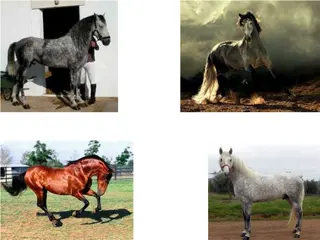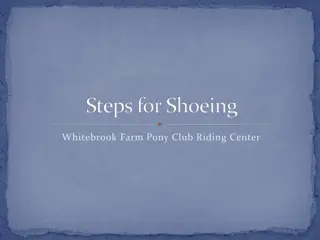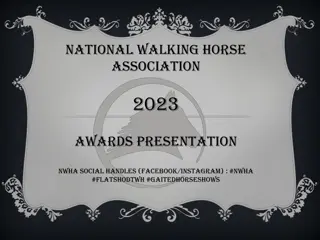Horse Facts and History Overview
Explore interesting facts about horses, including their vocabulary, classifications, and history. Learn about different terms associated with horses, such as filly, mare, stud, and more. Delve into horse-related concepts like gestation, foaling, and unsoundness. Additionally, discover historical milestones such as the early origins of horse racing and the establishment of the Pony Express in America in 1860.
Download Presentation

Please find below an Image/Link to download the presentation.
The content on the website is provided AS IS for your information and personal use only. It may not be sold, licensed, or shared on other websites without obtaining consent from the author.If you encounter any issues during the download, it is possible that the publisher has removed the file from their server.
You are allowed to download the files provided on this website for personal or commercial use, subject to the condition that they are used lawfully. All files are the property of their respective owners.
The content on the website is provided AS IS for your information and personal use only. It may not be sold, licensed, or shared on other websites without obtaining consent from the author.
E N D
Presentation Transcript
Horses PAFNR MS. SKINNER S
Vocabulary Filly: Name for a female horse until the age of 3 Mare: Name for a mature female horse; over 3 years of age Stud/Stallion: A mature male horse over 4 years of age used for breeding Foaling: The process of giving birth in equine animals Gestation: The length of time that a female animal is pregnant Unsoundness: Any condition that interferes with an animal s ability to function or to perform
Vocabulary Light Horse: A horse used primarily for riding, driving, showing, racing or utility on a farm or ranch. 14.3-16 HH, 800-1200 lbs Draft Horse: A large breed of horses used for work. 15 HH + and 1500lbs + Donkey: An equine animal with a short erect mane and tail; large ears; smaller and stockier than horses Cue: A stimulus used to train horses Equine: Animals that make up the equine family include: horses, donkeys, mules, ponies. Mini donkeys, ponies or horses Sire: A male parent of an animal
Vocabulary Feral: Horses that were once domesticated but are now wild Farrier: A person who shoes horses and cares for their hooves Purebreed: Animals with parents of the same breed Hinny: cross between a male horse and a female donkey; similar to a mule but smaller and more horse like Jack: A male donkey Miniature Horse: A very small horse
Vocabulary Progeny: The offspring or descendants of one or both parents Stock: Livestock domesticated for farm us Modified monogastric: Animals that have a single compartment stomach but can digest roughages and forages Gelding: Castrated male horse
4500 BC Horse Racing dates back to nomadic tribesmen of Central Asia (who first domesticated the horse).
1665 British settlers brought horses (and horse racing) to America. The first racetrack was laid out on Long Island.
1860 In April, the Pony Express was created! Young men once rode horses to carry mail from Missouri to California in the unprecedented time of only 10 days. Was the most direct and practical means of east-west communications before the telegraph.
1894 The American Jockey Club was started in New York, modeled on the English, which soon ruled racing with an iron hand and eliminated much of the corruption within horse racing.
1919 Sir Barton was the first horse to win the Triple Crown. This is racing s most prestigious prize- earned by winning the Kentucky Derby, Preakness and Belmont Stakes, only 11 horses have won this.
1940 The American Quarter Horse Association was formed in Fort Worth, Texas. Now there are close to 350,000 members.
2011 American Horse Slaughter Prevention Act of 2011 Purpose: To amend the Horse Protection Act to prohibit the shipping, transporting, moving, delivering, receiving, possessing, purchasing, selling, or donation of horses and other equines to be slaughtered for human consumption, and for other purposes. Did not pass, has been referred to committee.
Cons Pros No horse meat More animal cruelty Horse lovers are happy Too many horses, costs are lowered Lessens pedigree
Horse Racing A competition for horses ridden by jockeys within a given area and over a prescribed distance, under the control of appointed officials. Thoroughbreds are the most popular horse breed in the racing industry, but other breeds also race on Texas racetracks such as: Quarter Horses, Paint Horses, Arabians, and Appaloosas. There are currently 5 racetracks in Texas and over 950,000 industry participants.
Therapeutic Riding An equine-assisted activity that improves balance, joint mobility, coordination, muscle tone and posture. It can ease symptoms of a wide variety of disabilities including brain injuries, multiple sclerosis, hearing or visual impairments, muscular dystrophy, cerebral palsy, learning disabilities, Down syndrome, and cardiovascular disease. Plus, it's great for helping students improve motor skills, self- esteem, concentration and problem-solving abilities.
Ranching Cattle have been raised and herded in Texas by men on horseback since the Spanish conquistadors introduced cows and horses to the area around 1541. Today they are still used on ranches to gather and work cattle, check fences, and various other labor intensive jobs. A good ranch horse must be versatile and perform activities such as herding, cutting, roping, and reining. They should have keen cow sense, high endurance, and a gentle disposition. Most of the competitive sports performed on horseback today are based on activities that are performed on a working ranch.
Recreational Riding A popular pastime that strengthens your body and mind while exploring the great outdoors on the back of your horse. Almost 4 million horses are used for recreation more than any other use. Trail riding is an ever growing industry with many of our state and federal parks, forests, and wilderness areas becoming available to be explored on the back of a horse for a unique adventure. It has also become a potential income for landowners who may want to diversify their ranching operation by allowing trail riders to come in and ride and experience the country.
Texas Economic Impact of Activities Indirect $848 million Direct $506 million Racing Showing $1.9 billion $1.1 billion Recreation $1.5 billion $900 million Other $898 million $518 million Total $5.2 billion $3 billion
Activities Activity Choose one of these Horse Activities that most interests you. You must fill an entire page with why this interests you. This can include: Written reasons Pictures Cartoons Etc
History: The early improvement in the Quarter Horse-so called because of its great speed at one quarter of a mile. General Sam Houston rode a Quarter Horse. Characteristics: Weighs between 500 and 600 kilos, he is relatively small by comparison to other breeds. Average height is between 14.1 and 15.2 hands high Main Use: For speed in the quarter-mile races.
History: Brought to England from the Mediterranean Middle East around the turn of the 17th century and bred to the stronger, but less precocious, native horse. Characteristics: They are most often bay, seal brown, chestnut, black, or gray. Muscular. Main Use: Racing
History: When Europeans sought to improve their saddle horses, Arabians were imported to cross with native strains. The standard procedure was to use purebred Arabians, especially stallions, to improve stock. Characteristics: Dished profile with a prominent eye, large nostrils and small teacup muzzle Main Use: Strength, courage, stamina required for survival, speed and responsiveness
History: The Spanish introduced horses to North America as they explored the American continents. Eventually, as these horses found their way into the lives of Indians and were traded to other tribes. Characteristics: Spots and splashes of color, Main Use: speed on race track, advanced levels of dressage, jumping, games, reining, roping, pleasure, endurance and as gentle family horses
History: Origins of the Paint Horse in North America can be traced back to the two-toned horses introduced by the Spanish explorers, descendants of horses from North Africa and Asia Minor. Characteristics: Unique combination of white and any one of the colors of the equine rainbow: black, bay, brown, chestnut, dun, grulla, sorrel, palomino, gray or roan. Main Use: Ideal partner for pleasure riding, showing, ranching, racing, rodeoing, trail riding, or just as a gentle friend for the kids.
History: The first mention of a small horse being imported into the United States was in 1888; and research shows little public awareness of true Miniatures until 1960. Characteristics: they must measure no more than 34 inches in height at maturity Main Use: Showing and companionship























